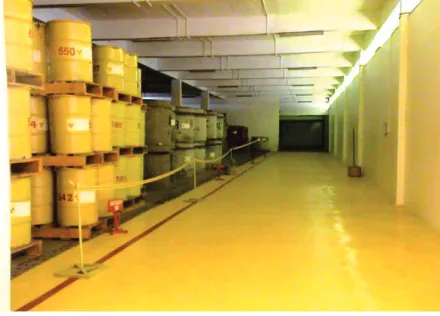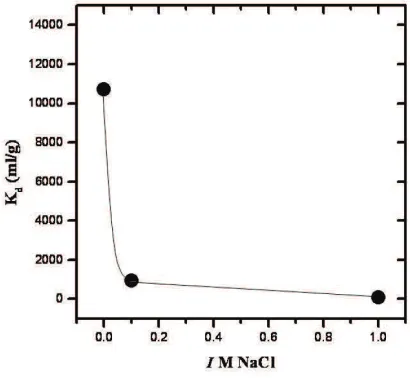137 Cs sorption into bentonite from Cidadap-Tasikmalaya as buffer material for
disposal demonstration plant facility at Serpong
B. Setiawan, H. Sriwahyuni, NE. Ekaningrum, and T. Sumantry
Citation: AIP Conference Proceedings 1589, 346 (2014); doi: 10.1063/1.4868816
View online: http://dx.doi.org/10.1063/1.4868816
View Table of Contents: http://scitation.aip.org/content/aip/proceeding/aipcp/1589?ver=pdfcov
Published by the AIP Publishing
Articles you may be interested in
Enhanced photocatalytic activity of Ag microgrid connected Ti O 2 nanocrystalline films Appl. Phys. Lett. 90, 122114 (2007); 10.1063/1.2715477
Pd H system in H 2 plasmas
J. Appl. Phys. 97, 043304 (2005); 10.1063/1.1844607
Photon-stimulated desorption of F ions from CF 3 Cl adsorbed on Si(111)-7×7 J. Chem. Phys. 120, 11144 (2004); 10.1063/1.1738638
Theoretical studies of hyperthermal O ( 3 P) collisions with hydrocarbon self-assembled monolayers J. Chem. Phys. 120, 7696 (2004); 10.1063/1.1688312
137
Cs Sorption Into Bentonite From Cidadap-Tasikmalaya
As Buffer Material
For Disposal Demonstration Plant Facility at Serpong
B. Setiawan
*, H. Sriwahyuni, NE. Ekaningrum, T. Sumantry
Radwaste Technology Center-National Nuclear Energy Agency, PUSPIPTEK, Serpong-Tangerang, INDONESIA 15310
* Email: bravo @batan.go.id
Abstract. According to co-location principle, near surface disposal type the disposal demonstration plant facility will be build at Serpong nuclear area. The facility also for anticipation of future needs to provide national facility for the servicing of radwaste management of non-nuclear power plant activity in Serpong Nuclear Area. It is needs to study the material of buffer and backfill for the safety of demonstration plant facility. A local bentonite rock from Cidadap-Tasikmalaya was used as the buffer materials. Objective of experiment is to find out the specific data of sorption characteristic of Cidadap bentonite as buffer material in a radwaste disposal system. Experiments were performed in batch method, where bentonite samples were contacted with CsCl solution labeled with Cs-137 in 100 ml/g liquid:solid ratio. Initial Cs concentration was 10-8M and to study the effects of ionic strength and Cs concentration in solution, 0.1 and 1.0 M NaCl also CsCl concentration ranging 10-8– 10-4M were added in solution. As the indicator of Cs saturated in bentonite samples, Kd value was applied. Affected parameters in the experiment were contact time, effects of ionic strength and concentration of CsCl. Results showed that sorption of Cs by bentonite reached constantly after 16 days contacted, and Kd value was 10.600 ml/g. Effect of CsCl concentration on Kd value may decreased in increased in CsCl concentration. Effect of ionic strength increased according to increased in concentration of background and would effect to Kd value due to competition of Na ions and Cs in solution interacts with bentonite. By obtaining the bentonite character data as buffer material, the results could be used as the basis for making of design and the basic of performance assessment the near surface disposal facility in terms of isolation capacity of radwaste later.
Keywords: Demonstration plant, buffer, bentonite, sorption characterization
PACS: 89.60.Ec
INTRODUCTION
Radioactive Waste Technology Center located in Serpong-Tangerang has main job to manage, conduct research and service to all aspects related to radioactive waste management in Indonesia [1]. By using evaporator, incinerator and compactor equipments, all radioactive wastes could be treated to produce radioactive waste packages in a 200L drum and 350L or 950L concrete shell of containments. All of waste packages and then storage in an interim storage facilities, called as interim storage (IS) no 1 and no 2 see Figure 1 [2].To anticipate decreasing of IS-1 and 2 capacity, then needed another facility to accommodate the packages such as a radwaste disposal facility which is also has a function as a demonstration facility purpose in Serpong. Several packages of existing waste at IS-1 and IS-2 could be sent to the demonstration of radwaste disposal facility. According to co-location principal, the demonstration plant of disposal to be used for low-activity radwaste with short half-life (less than 5 year) [3] from non-nuclear power plant activities is at same location with the waste producer such as reactor, nuclear element
fabrication and radioisotope producer facilities at Serpong. By taking into account the safety of people and environment, it is also intended to anticipate future needs for preparation of facility for nationwide service of non-NPP radwaste management at Serpong area. According to International Atomic Energy Agency guidance, appropriated facility type for demonstration plant at Serpong is a near surface disposal (NSD) type [4]. So that all the technical aspects related to the disposal type needs to be study and developed further. One of the technical aspects that need to be developed is for buffer and backfill design concept of demonstration plant NSD type, where specific information and data of buffer and backfill materials must be obtained in order to created the design concept meet with condition of prospective location for disposal will be located. For that purpose, a local bentonite has been planned as buffer and backfill materials for planned disposal facility.
FIGURE 1. View of waste packages in IS-1 building
Reliability of material for buffer purpose could be known from their capacity to hold groundwater flow in order to avoid direct contact between groundwater with waste packages or at least be able to delay travel time of groundwater reaches waste packages were stored in disposal facility [5]. Moreover the buffer material must be able to absorb any possibility of radionuclide release from disposal facility into environment. And the distribution of radioactive contaminant will be isolated just around the disposal facility. The higher radionuclide sorption capacity by buffer material then better the function of material to isolate any radionuclide release to environment. Figure 2 is illustrated a kind of NSD type disposal.
FIGURE 2. An illustration of NSD type disposal
Reliability indicator of buffer material called as distribution coefficient,
With ܽ denotes amount of metal ion absorped into solid phase per-mass unit and ܾ is the amount of metal ion remains in solution per-volume unit. ܣ and ܣ௧ were initial and final activity of Cs-137 in
solutions, and ܸ was the total volume of solution in 20 ml PE vial (ml), m was weight mass of samples (g), respectively.
Radiocesium (Cs-137) used on the experiment relatively has long half-life (around 30 y) and has a similar behavior with K+ ion are mobile in a various environment system and easily assimilated with plants and organisms in water and soil so it can be easily enter into food chain in an enough wide range condition [6]. In general, radionuclide ability to stay in environment depends on the magnitude of sorption capacity of solid phase as confinement material. And clay material such as bentonite is known has ability to absorb and isolate radionuclide [7] that is one of the reasons for the use of clay material as a barrier on a radwaste disposal facility system.
Objective of the experiments are to study performance reliability in one of the disposal system that can ensure environment safety to people such as buffer material reliability through information of radiocesium sorption capacity of bentonite from Cidadap-Tasikmalaya, West Jawa. The results could be used for the basic of design concept preparation and performance assessment of NSD facility in term of radwaste isolation capacity and environment safety.
METHODOLOGY
The used bentonite was obtained from a mining company PD Agribisnis dan Pertambangan Province of West Jawa, Karangnunggal-Tasikmalaya. Previously bentonite was clean up and then crushed, sieved to 100 mesh particle size and dried naturally before used as experiment samples. Radiocesium was obtained from Eckert & Ziegler and used without further preparation, while other chemical solutions were CsCl and NaCl from Merck. For radiometry analysis was used multichannel analyzer from
Canberra.
Bentonite samples were contacted with a solution containing 10-8 M CsCl with solid:liquid ratio was
ͳͲିଶ g/ml in a 20 ml PE vial. Contacting was
conducted by using roller equippment and periodically sample was picked out. Solid and liquid phases was seperated by using syringe equipped with m filter. The aliquot and then measured their activities by using MCA. Contacting is continued until reach the equilibrium contact time, and the saturated time was used for further experiments.
10-3 M CsCl. All the experiments were done at Chemistry laboratory of PTLR-BATAN in 2012 FY.
RESULTS AND
DISCUSSIONS
The result of uptake profile of Cs-137 as sorption kinetic data of bentonite expressed by distribution coefficient versus contact time was showed in Figure 3. Seen that the ܭௗ values reached constantly after contact time of 16 days, with ܭௗ value around 10.600 ml/g at CsCl concentration was 10-8 M.
FIGURE 3. Sorption kinetic of Cs-137 into bentonite samples
From the figure could be seen that sorption distribution of Cs-137 into bentonite samples has been occurred in 2 steps. This information corresponds to the information that bentonite is non-metallic mineral composed of 2 layers where the sorption process of metal ion on their interlayer through ion exchange processes [8].
FIGURE 4. Effect of ionic strength to Cs-137 sorption into bentonite
Results of the ionic strength effect in solution to radiocesium sorption into bentonite samples were showed in Figure 4. Increasing in concentration of NaCl as background salt in solution has resulted decreased of Kd values of Cs-137. This is expected due to competition between Na+ and Cs+ ions in the solution into bentonite samples occurred [9].
Further experiment was to study the effect of CsCl concentration in solution when interacted with bentonite samples. The method was done by varying the initial concentration of CsCl in solution and then contacted to bentonite samples. Given initial concentrations were ranged from 10-8 to 10-4 M CsCl. Contacting process was carried out for 16 days and the result was shown in Figure 5. In general seen that Kd values would decreased with increasing in CsCl concentration in the solution, and this is in accordance with the philosophy of the distribution coefficients of metal ions in the solid-liquid phase system.
FIGURE 5. effect of CsCl concentration to Cs-137 sorption into bentonite
CONCLUSION
A series of radiocesium sorption experiments into bentonite samples from Cidadap-Tasikmalaya have been done where sorption capacity of bentonite from Tasikmalaya have a pretty good results seen from ܭௗ values reached around 10.600 ml/g after contacted in 16 days. Saturated of Cs-137 sorption into bentonite was achieved in 2 stages reflecting that bentonite was a double layer mineral. Increasing in the initial concentration of CsCl in solution has lowered the ܭௗ values, and increasing in concentration of NaCl has decreased the ܭௗ values. There were expected due to the limited capacity of bentonite samples and due to a competition between Na+and Cs+ions interacted with active site of bentonite. The data were hopely to be used as one input for the safety assessment on a radwaste disposal activity in the near future.
REFERENCES
1. PTLR, Strategic Plan of PTLR 2010-2014, PTLR-BATAN, 2010 – in Indonesian.
2. BATAN, Indonesia National Report for the Simulated Joint Convention Group Session: on the Safety of Spent Fuel and on the Safety of Radioactive Waste Management, Tokyo, ANSN-IAEA, 2010.
3. Y., Kawakami, Review of Site Evaluation Activities for a RW Disposal Facility in Jawa Island, Report of IAEA EBP-Asia Expert Mission, Serpong–Banten, Indonesia, 25-29 Feb 2008, Vienna, IAEA, 2008
4. D., Susilowati, “Preliminary Assessment on
Conceptual Design of Near Surface Disposal for
Radwaste”, Proc. Result of Researches and
Activities of PTLR 2009 Year, PTLR-BATAN, 2010, pp.279-288 - in Indonesian
5. IAEA, Safety Guide, Siting of Near Surface Disposal Facilities, SS no. 111-G-3.1, Vienna, IAEA, 1994.
6. S. Staunton and M. Roubaud, Clay and Clay Minerals, Vol. 45, No.2, pp.251-260 (1997). 7. RM., Cornell, J. Radioanal Nucl Chem 171,
pp.483-500, (1993).
8. Encyclopedia of Geological Science, Mc Graw-Hill, NY (1978).

